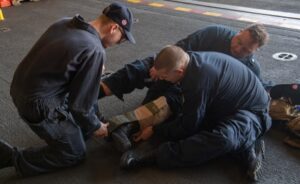
250321-N-HJ896-1102 SASEBO, Japan (March 21, 2025) Sailors assigned to the forward-deployed amphibious assault ship USS America (LHA 6), respond to simulated casualties during a medical training event in the ship’s hangar bay in Sasebo, Japan, last month. U.S. Navy Photo by Petty Officer 2nd Class Amy Mullins
WASHINGTON, DC — The current state of combat-casualty readiness in the military health system has degraded to the point where the country is unprepared to care for the casualties that would result from a major conflict, experts told Congress last month.
“If we maintain the status quo and enter a pure conflict unprepared, we will condemn thousands of war-fighters to death,” testified Jeremy Cannon, MD, USAF (Ret), professor of surgery at the University of Pennsylvania. “Without intervention, the MHS will continue to slide into medical obsolescence.”
The status quo that Cannon was lamenting is that, in general, only 10% of military surgeons see the patient volume, acuity and variety that they need to remain combat ready.
“Projections estimate that a pure conflict could produce as many as 1,000 casualties per day for 100 days straight—a scale not seen since World War II,” he explained to the House Armed Services Committee. “One in 4 with survivable injuries will die at the hands of an unprepared system.”
Civilian hospitals would also be unprepared if they were asked to handle the overflow of combat casualties, explained retired Air Force Maj. Gen. Paul Friedrichs, MD, former joint staff surgeon at the Pentagon.
“We have a shell game right now with the Guard and Reserve and civilian facilities,” Friedrichs explained. “We’re going to pull them out, deploy them and assume that civilian facilities [can handle overflow]. During COVID, [they] required 70,000 military medics to take care of the surge in demand. Instead, we’re going to lower their staff and then [ask them to] take care of the surge in demand. The math doesn’t work.”
Both experts and legislators agreed that the country has fallen into the trap of what is commonly known as the “peacetime effect,” where, during peacetime, medical teams focus on the treatment of ordinary illnesses and are caught unprepared when conflict erupts.
To break free of that cycle will require focus and funding, Friedrichs said.
“Healthcare is not cheap. The mistaken belief that somehow military medicine can be done at a lower cost than in the civilian sector and be ready for conflict is just that. It’s a mistake,” he declared. “We need our key hospitals to be Level 1 trauma centers. But to do that we must address the elephant in the room, and that’s resourcing. The medical inflation rate on average since 1938 is 5.1% per year, and the military has seen a net 12% reduction in funding. There is no way to fix these problems if the military health system is seen as a bill-payer and not something worth investing in.”
That investment should include a boost in combat-casualty research, Cannon noted.
“To succeed on complex future battlefields, DoD medical research must refocus on pre-hospital care, team training, bleeding control, battlefield blood transfusions, regenerative medicine and long-term outcomes,” he said.
To benefit from this kind of sweeping change, witnesses stressed how DoD needs to rethink how combat casualty is structured.
“A joint casualty stream requires a joint casualty care team,” explained Friedrichs. “That seems relatively straightforward, yet that’s still something we’re arguing over. Whether medical units should be interoperable. Whether they should all have the same equipment and the same training. The answer is yes. Look at almost every other country with a large military. They’ve already made these changes.”
This would not require another reorganization of military medicine but a strengthening of the Joint Trauma System, which was created to improve trauma care across the services.
“No one in DoD truly owns combat-casualty care,” said Cannon. “In 2017, the Joint Trauma System was codified in law. This committee must now strengthen the statutory language to affirm that JTS owns combat-casualty care, adding top-down authority and bottom-up support.”
This strengthening of combat-casualty care needs to extend beyond the military, he added, requiring a “whole-of-society” road map linking military, VA and civilian healthcare systems for both peacetime readiness and large-scale combat operations.
These changes need to happen quickly, Cannon added. “We need to put our foot on the gas. We don’t have 5 years, 10 years, 20 years. We need the solution now.”

